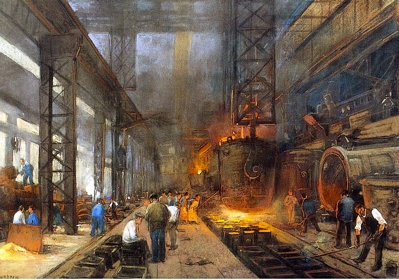Radicals and Reform
Radicalism took on many forms in 19th century Britain. The beliefs and motivations of radicals varied widely, but the most influential were able to gain the support of workers and show potential for bringing about reform. Workshops, factories, trade societies and unions became fertile ground for organizing workers and gaining support. Trade society and union meetings were a natural target for radicals who hoped to spread their message to large sympathetic audiences. As Karl Marx said, “Without the Trades Unions no mass meeting is possible” (Prothero 106). However, to succeed, radicals needed to walk a delicate line. On the one hand, they clearly wanted to agitate for a shift in power, but if they became to radical and were perceived as a threat it would be easier for the government to shut them down.
The Chartist movement is an example of a radical organization that attempted to balance these challenges. The Chartists’ goals centered around gaining political equality for the working class. The movement gained strength in London and northern manufacturing towns, were eventually Fergus O’Connor became the acknowledged leader. O’Connor and the Chartists faced a difficult problem – make political change in a system where the majority of those who wanted the change couldn’t vote. As Slater states in his work, “Making of Modern England”:
Public meetings obviously could be held, monster petitions could be presented to Parliament, resolutions could be carried and forwarded to the Member for the district to the Primer Minister, and even, as O’Connor was showing, a local newspaper could be established with a larger circulation than any other paper outside London. But all these methods of constitutional agitation, so effective when exercised by voters, it was shrewdly suspected would fail in their effect when it was known that the petitioners and demonstrators could not turn out a single member of Parliament. Hence the great cleft of opinion that speedily arose between the advocates of physical force and moral force; a division of opinion which could not be satisfactorily settled (Slater 154).
The Chartists faced a classic radical dilemma that threatened their unity and success. O’Connor attempted to appease both Chartist factions by publicly using violent rhetoric and privately arguing for moderation. Ultimately, the government was able to arrest Chartist leaders for either inciting violence, or seditious libel, which lead to the decline of the organization.
However, the movement was not a total failure. By 1848 many of the original Chartist demands, like voting by ballot and reduced property requirements for Parliamentary service, had been removed. Once again, the Chartists illustrate a common radical trend – reform by partial victory. Radicals may not always have achieved their goals, but their agitation shifted policies over time, and certainly led to improved rights for the working class over the course of the 19th century.
- Adam Bischoff


